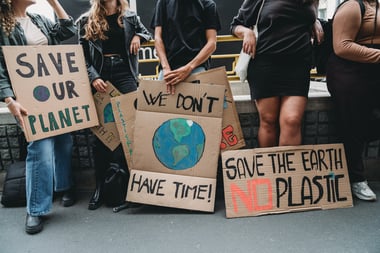It's estimated that plastic releases more emissions per year than aviation and shipping, which is mostly down to its reliance on oil, contributing to climate change. And given humans throw away 353 million tonnes of plastic per year, this figure is likely to increase in the coming years.
Not only are we eating through fossil fuels at a rapid rate, but we are also destroying the air, land, and water quality through the emissions associated with this industry.
If we want to move away from this destruction, we need to intertwine environmental sustainability into our everyday lives. So let's look at why environmental sustainability is crucial, how we can achieve it, the benefits of it, and the environmental challenges the planet currently faces.
At CleanHub, we’re committed to helping brands reduce their plastic footprint and work toward a more circular economy. What are your brands sustainable goals this year? Get in touch, we'd love to chat about how we can help you achieve those goals with a partnership.
What's on this page?
01 | The importance of environmental sustainability02 | What are the benefits of environmental sustainability?
03 | How to achieve environmental sustainability
04 | Economic growth and environmental sustainability
05 | ESG and environmental sustainability
06 | The bottom line
What is environmental sustainability?
Sustainability can be broken down into three main areas: social, economic, and environmental — otherwise known as the Three Pillars of Sustainability.
The 'environmental' pillar of sustainability encourages people to live in a way that doesn’t put stress on natural resources. With this in mind, we can maintain an ecological balance in our planet’s natural environment, which will benefit today’s ecosystems and protect future generations.
Want to learn more about this term? Check out our guide What is Environmental Sustainability? for everything you need to know.
The importance of environmental sustainability
Environmental sustainability is one of the biggest hopes we have in reversing the climatic disasters taking place on the planet right now.
To give you a better idea of how it works, let's take a look at why we need environmental sustainability for a healthy future.
It considers future generations
Our increasing levels of waste and the rising global temperatures suggest our planet is not on a good trajectory — with some experts claiming we're heading towards the point of no return.
Without environmental sustainability, climate disasters and severe weather events will become increasingly common. We only need to look at the past couple of years to see this unfold in real time.
For example, more than 33% of Pakistan went underwater in 2022, due to severe floods caused by climate change. It was estimated that 33 million people were displaced and roughly 1,200 died from this disaster — and this all started with a severe heat wave that melted glaciers, followed by an extreme monsoon.
At the same time, more than 66% of Europe received a severe drought warning — the worst drought in at least 500 years.
And in 2023, countries across the world broke records for blistering temperatures. For example, Vietnam recorded its highest temperature ever at 111.3 °F in the south of Hanoi on 6th May, while Sanbao (a remote town in China) reached a national record of 125.96 °F. China’s capital even endured a temporary ban on outdoor work during its hottest month of the year.
This all seems very bleak — but there is hope that we can change things around. That's why cities around the world have already started working towards environmental sustainability. We look at the best examples of this on our page The Nine Greenest Cities in the World.
Protects wildlife
People around the world have become disconnected from nature over the past century, so it's easy to forget how dependent we are on wildlife.
Everything is connected — decreasing fish populations can put large sea mammals at risk of extinction, just the same as lower smaller pollinator numbers can put human food stocks at risk.
Unfortunately, we are failing wildlife miserably at the moment. Humans are pumping out harmful emissions, destroying habitats for industrialization, wiping out ecosystems for materials, poaching animals, littering waste in the open environment, and contributing to ocean pollution.
We urgently need to protect habitats and precious ecosystems — and here's how:
- Protect vulnerable animal populations – When laws are put in place to protect animals, populations naturally rise. The figures speak for themselves. For example, the ban on commercial whaling in 1986 led to a strong recovery of humpback whales around the world, and now this population is thought to be around 93% of its original size
- Continue conservation efforts – We need to carry on supporting coral reefs, rebuilding wetlands, planting trees in depleted regions, and creating wildflower meadows. All of this needs to be done with expert knowledge, to make sure it's done effectively and puts wildlife first
- Introduce more legislation on protecting nature – As well as protecting wildlife, we need to protect the nature they live in too. But this can only be effective if laws are put in place. For example, fully protected marine areas can increase the total biomass of marine life by more than 400%
- Reduce emissions – We drastically need to reduce our emission output to limit the impact of climate change and global warming. As the years go by, we're seeing more severe weather events, which are destroying habitats, reducing food and water supplies for animals, and causing detrimental impacts on population sizes of some animals
- Create a circular economy – Fed up of seeing plastic waste littered around the planet? The key solution is to introduce a circular economy. This way, we can feed materials back into businesses, reduce our reliance on raw materials, lower emissions, and lessen the chance of animals eating plastic
Improves human health
It's estimated that an average of 9 million people die globally from air, water, soil, or ocean pollution each year. This clearly shows that we need environmental sustainability to not only improve our health but also remove a major threat to life.
From breathing in polluted air to eating contaminated food, there are numerous ways in which environmental degradation is taking a toll on our lives. You can find out everything you need to know by visiting our blog post: How Does Plastic Impact Human Health?
The benefits of environmental sustainability for businesses
Embracing sustainability is crucial for reversing climate change. Its benefits aren’t just limited to nature either — there are also numerous commercial and financial benefits for brands and organizations.
Here are the top benefits of environmental sustainability for businesses.
Reduced energy costs
Energy and water consume a massive chunk of organizations' finances.
When companies focus on reducing their consumption to achieve environmental sustainability in the manufacturing process, they observe long-term savings. For instance, businesses that install solar panels can save up to 70% on their electricity bills, according to the Solar Trade Association.
Attracts a wider customer base
Roughly 73% of Americans and 84% of Europeans are likely to stop purchasing from companies that don’t incorporate sustainability in their businesses and don’t care about climate change.
This shows that sustainability is no longer a choice for brands — they need it to stay relevant in the business arena.
And by publicizing your green initiatives, you’ll also gain a new customer base that wasn’t aware of your sustainable business practices.
Tax benefits
Many governments around the world have acknowledged the current environmental crisis, and are providing tax incentives to companies carrying out sustainable business practices. The main ones include:
- Database of State Incentives for Renewables & Efficiency - This is based in the US, but the number of incentives will vary from state to state
- Council Directive 2003/96/EC - This is available for countries in the European Union (EU)
Improves workforce morale
Introducing sustainability in a business is a collaborative effort. When teams within organizations work and collaborate toward developing green initiatives, they feel a sense of pride, which improves their morale and positively impacts the corporate culture.
In fact, a recent study found that 71% of job seekers want to work for environmentally friendly employers.
Lowers environmental impact
Having an environmentally sustainable business isn’t just about profitability and making your business look good, it can make a real difference.
By incorporating eco-friendly practices, you’ll reduce your company’s carbon footprint, which will result in fewer greenhouse gas emissions, less waste, and improved air, land, and water quality.

How to become more environmentally sustainable
Achieving environmental sustainability isn’t possible without striving on both personal and professional levels. So here’s how you can make your life and business more sustainable:
In personal life
Change starts from within, so there’s no better way to improve the environment without changing our day-to-day lives.
Here are a few tips that you can incorporate into your daily life to help reduce your carbon footprint:
- Try to consume less — Products all require materials and energy to make them. That means it's a good place to start by reducing your overall consumption
- Try to eliminate plastic from your life — It's a good idea to start off small. For instance, getting reusable straws, cups, and grocery bags might seem like small swaps, but they have a big impact over time
- Investigate labels for harmful materials/ingredients — This goes for all products, but especially on clothing (steer clear of polyester!)
- Avoid wasting water — You can even go a step further and recycle water where possible, or carry out rainwater harvesting
- Cut back on car emissions — An easy way to do this is by simply opting for public transport, cycling, or walking, rather than driving
- Invest in renewables for your home — Solar and wind are both much more accessible and affordable for homeowners than they were a few years ago
- Consider the carbon footprint of your diet — Reduce meat consumption (or avoid meat altogether), purchase from your local farmer’s market, and avoid wasting food
- Spread the word — The more people that do their bit for the planet, the better
In work life
The business world is different from our personal lives, but it also has massive potential for improvement. That's why we've listed a few ways you can make your business eco-friendly:
- Assess your products — It's important to look at the whole picture too, which means you should conduct a life cycle assessment of your product or service
- Rethink your supply chain — Change the manufacturers or service providers who don’t consider environmental sustainability in their business.
- Create an Environmental, Social, and Governance (ESG) strategy — More businesses are having to consider creating an ESG plan, as governments around the world introduce new laws and consumers ask for greener brands
- Get your employees involved — By making your employees a central part of your environmental sustainability strategy, you can ensure there will be change in all areas of the business
- Make your office space eco-friendly — Think greenery potted around the place, solar panels on the roof of the building, heat pumps to keep employees warm, and efficient recycling facilities in place
- Incorporate the circular economy in your manufacturing process — Not sure where to start with this? We'd recommend getting a packaging assessment from an expert, who will have the know-how when it comes to reducing waste and feeding plastic back into the economy
- Collaborate with third-party companies — These can help you improve the environment, reduce your carbon footprint, and lower your plastic consumption. And that's what we do at CleanHub. Companies partner with us to support the collection and safe processing of plastic waste in coastal regions. Head over to our live dashboard to see real-time data of the recovered material coming in.

Economic growth and environmental sustainability
Many conventional business practices are immensely harmful to the environment. Take plastic packaging in ecommerce, for example. A recent study found that ecommerce generates around 4.8 times more packaging waste than in-store purchasing.
Even though these practices might be cheaper than a sustainable alternative, we need to ditch them to align profits with both people and the planet.
And as companies grow, and profit climbs, energy use also increases, which is often derived from non-renewable sources, such as fossil fuels, and pollutes the environment.
This doesn’t necessarily mean that the business world is doomed. Brand leaders simply need to look at more innovative ways to run their ships and become more environmentally sustainable.
And sometimes, innovation isn’t even required — some brands just need to make a few small swaps around the business to incorporate sustainability into everyday operations. Simply switching to solar or wind power, instead of fossil fuels, can have a hugely beneficial impact on the environment — and it can cut costs in the long run.
The only issue is these innovations or swaps in practice is that they require initial investment. But given the expected future of businesses revolves around sustainability, this seems like an obligation, rather than a choice if companies want to stay ahead of the curve.
ESG and environmental sustainability
More people are becoming acquainted with the terms Environmental, Social, and Governance (ESG) — but what exactly is it?
An ESG strategy is a framework businesses adopt to show they take the environment, social impact, and governance seriously.
Sustainability is intertwined with the first pillar — the environment — meaning businesses need to adopt greener practices if they want to have an effective ESG strategy.
When it comes to shaping up a business, different industries will have different priorities — for example, ecommerce drastically needs to look at its transport emissions, while the food industry should analyze how to reduce plastic packaging.
But brands are stepping up. In fact, 96% of the world’s biggest 250 companies now report on sustainability or ESG matters, according to KPMG.
Want to learn how you can market your ESG strategy effectively? Check out our guide on how to communicate your ESG strategy.
The bottom line
Environmental sustainability is the key to human well-being in the present and future.
The only way to reverse climate change and avoid climatic disasters is to live in harmony with nature. By compromising the planet, we are compromising our growth, development, and even survival.
We each need to assess how we can lessen our impact on the planet — on both an individual level and a business one.
Want to become more environmentally sustainable? At CleanHub, we’re committed to helping brands reduce their plastic footprint and work toward a more circular economy. If you want to get involved, all you have to do is get in touch with one of our in-house experts.

.webp)
-3.png)

.webp?width=380&name=CleanHub-processing%20(1).webp)
.webp?width=380&name=ESG-laptop%20(1).webp)
.webp?width=380&name=Diversity-and-inclusion%20(1).webp)


.webp?width=380&name=Refill%20product%20(1).webp)

.webp?width=380&name=Picking-up-plastic-waste%20(1).webp)
.webp?width=380&name=DEI%20(1).webp)
